
TOPSYS & TURVYS by Peter Newell (1862-1924) was originally published over a hundred years ago. It's the same with all of Peter Newell's work: all published over 100 years ago and all of his six "novelty books" ( such as THE SLANT BOOK, THE HOLE BOOK) are still in print. He also wrote and drew a newspaper comic strip titled THE NAPS OF POLLY SLEEPYHEAD (1906-07). There were, at the beginning of the 20th century, a slew of fantasy strips -- of which only LITTLE NEMO is remembered today.
Above is the cover of the Dover edition ("designed for years of use!") and it includes selections from TOPSYS AND TURVYS (1893) and TOPSYS AND TURVYS - NUMBER 2 (1894). No copyright information at all in here.
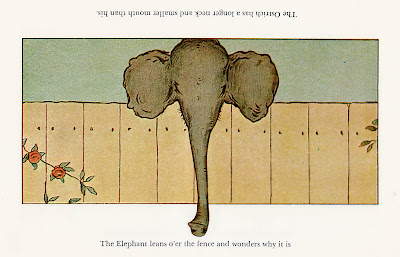
"The Elephant leans o'er the fence and wonders why it is"
The idea is that you look at Newell's drawing and read the line -- and then, turn the book over:
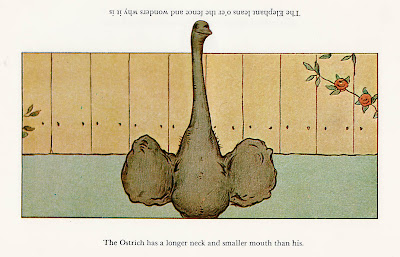
"The Ostrich has a longer neck and smaller mouth than his."
And you see a different picture, with a rhyming conclusion. Note: other blogs would just snidely tell you to turn you monitor upside down, but here at Mike Lynch Cartoons, we're all about customer service. Below is the same picture, upside down. No need to strain, gentle blog reader! Thank you and have a nice day.

"This troop of soldiers, all in a file, are looking near and far"
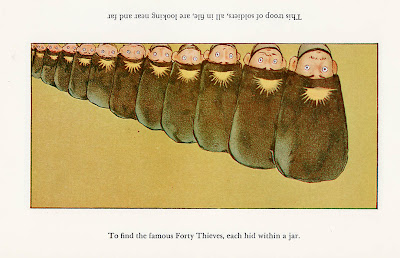
"To find the famous Forty Thieves, each hid within a jar."
Most of the time, I look at that first picture and can't figure out what the upside down version will be and how it relates. Some wonderful work.
"Peter Newell liked to say that he and the Civil War both broke out in this country at the same time. He was born near Rice's Corners, McDonough County, Illinois, on March 5, 1862, the fourth child of George Frederick Newell, an Ohioan, and Louisa Dodge of Chautauqua County, New York. His childhood years were spent in Bushnell, a small town in west-central Illinois."
- from the Peter Newell Family Papers at Yale University; bio by Sandra J. Markham
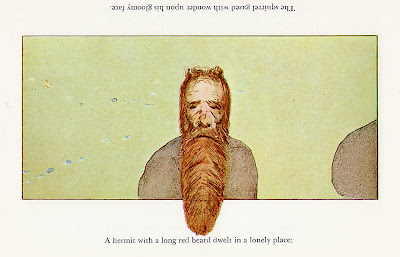
"A hermit with a long red beard dwelt in a lonely place"
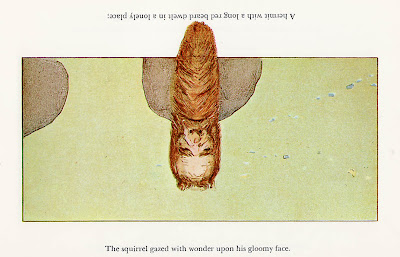
"The squirrel gazed with wonder upon his gloomy face."
"By the spring of 1883 he had moved east to New York, where he enrolled in classes at the Art Students' League while hoping to find steady employment as an illustrator for periodicals. His work had been published in the New York Graphic and Harper's Bazaar by the fall of 1883; the appearance of his simple line drawn comics was the beginning of a career in humor that would make Peter Newell one of the more prolific and best-known illustrators of his day."
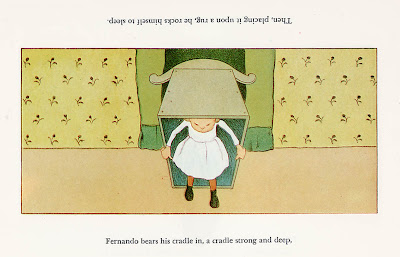 "Fernando bears his cradle in, a cradle strong and deep"
"Fernando bears his cradle in, a cradle strong and deep"Newell had good timing.
Ahh! Those were the days!
"By 1893 the development of halftone reproduction had made possible the style of illustration for which Newell is best remembered, the continuous tone drawing. His single-frame comics underscored with short, whimsical rhymes began appearing in Harper's Monthly and other magazines at this time. He was catapulted to fame by one in particular, "Wild Flowers," which appeared in the August 1893 issue of Harper's Monthly; several of these comics were compiled in one volume as Peter Newell's Pictures and Rhymes, published by Harper in 1900. Soon nearly every issue of most of the Harper magazines, as well as some Cosmopolitan, Metropolitan, McClure's and Collier's, carried a Newell comic or a Newell-illustrated story by authors such as John Kendrick Bangs, Stephen Crane, Philip Curtiss, Burges Johnson, Frank Stockton and Mark Twain."
Ahh! Those were the days!
In 1894, the successful illustrator Newell and his family moved to Leonia, NJ.
"Over the next twenty years Leonia grew to become an illustrators' colony much like the one centered around the Pyle-Wyeth group near Wilmington, Delaware. The lively community of artists formed clubs, theatrical and lecture societies, and held exhibitions, costume parties and pageants. The Leonia School of Illustration was opened there by artists Harvey Dunn and Charles Chapman. The Newell family participated in all aspects of the intellectual, musical, religious and social life of the community. Peter Newell was a founding member of the Men's Neighborhood Club of Leonia and served on the village's first Board of Health. He played the cello, though apparently not well, and was a popular toastmaster and lecturer known for his "chalk talks" and other impromptu presentations. Both of the Newell daughters married illustrators, and Howard and Josephine Newell McCormick became leading members of the second generation of artists to live and work in Leonia."
The house wasn't just any house. It was featured in an article in Scientific American and a picture postcards as well!
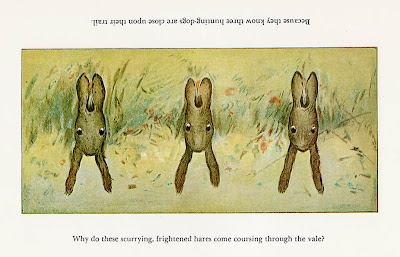
"Why do these scurrying, frightened hares come coursing through the vale?"
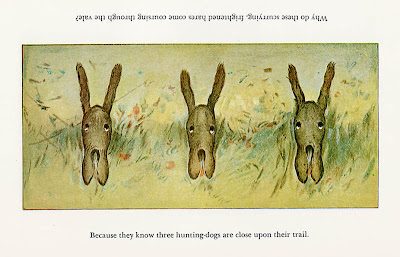
"Because they know three hunting dogs are close upon their trail."
"By the end of that year Peter Newell had become physically crippled by amyotrophic lateral sclerosis and was unable to work; he died in his home on January 15, 1924, at the age of 61."
More: Philip Hofer remembers in a 1934 essay on Newell's career from Nonesenselit.org.
Related: Cartoonist Gustave Verbeek also tread the same ground with his latter comic strip THE UPSIDE DOWNS in which he drew a six panel Sunday page which your would read all the way through and then turn it 180 degrees to read the conclusion. Barnacle Press has many of the strips here.


Wow! Mike you continually impress me with how much stuff you know, at least I hope that's it and not that I know so little. I had never heard of this artist but his work is amazing! Of course I had to rush over and order a couple of his books from Amazon.
ReplyDeleteI hope you won't mind if I link up to this post from my blog this weekend. I've got a thing for upside-down art you know. ;)
Most of the time you really can't tell what it's going to be, turned over. Clever work!
ReplyDeleteTrade, thanks for the kind words.
ReplyDeleteJack, I agree: you can't figure them out when you try and "cheat." The guy with the beard one is a great example.
Peter Newell was such a major name back in the day, and even though he has a half dozen books still in print, he is not a well known writer/artist/cartoonist. I always liked his TOPSYS & TURVYS work since I picked up that Dover edition many years ago.